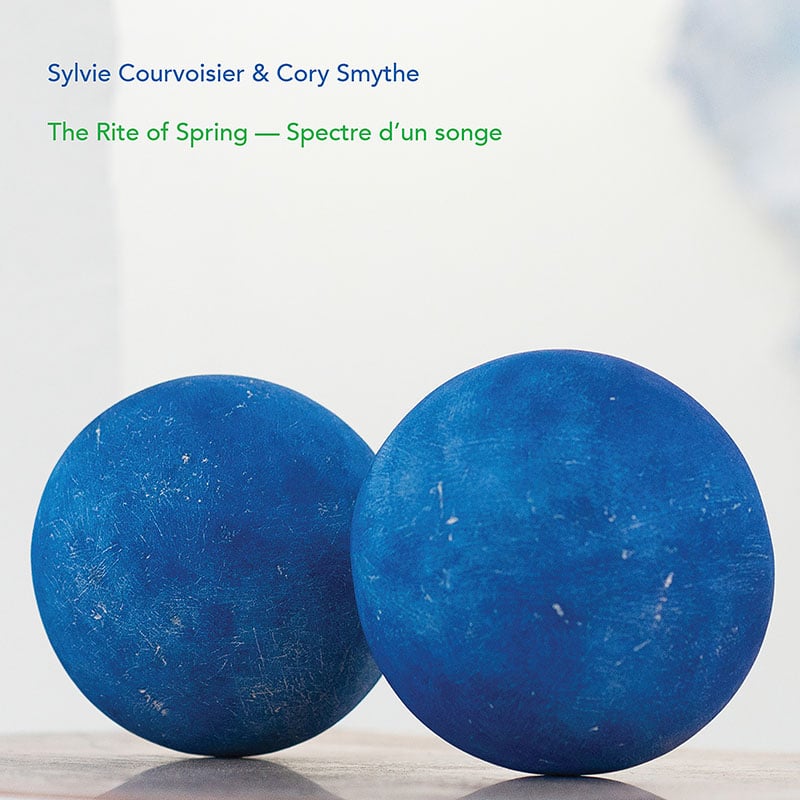Sylvie Courvoisier & Cory Smythe – The Rite of Spring – Spectre d’un songe
A unique album! An album defined by both its ambition and its execution.
It is unnerving to realise that Stravinsky’s ‘The Rite of Spring’ has been with us for 110 years: the power to thrill, surprise and challenge still there. ‘The Rite of Spring’ is one of the landmarks of twentieth century music, towering over the music of the century in the way that Picasso’s work dominates the art world.
Sylvie Courvoisier and Cory Smythe decided to use the masterwork: to interpret it and reimagine it. ‘The Rite of Spring’ is a piece I’ve loved for as long as I can remember,’ Courvoisier says. ‘It’s not an easy piece. It is an incredible challenge.’ Sometime ago, Courvoisier began work on a solo arrangement of ‘The Rite of Spring’, taking liberties with the original in the spirit of jazz interpretation. However, the guardians of the Stravinsky estate would only allow piano performances of the Rite in the composer’s version for two pianos or four hands. Nothing daunted, Courvoisier sought out a pianist who would relish playing the original score and would also engage with the new Courvoisier composition ‘Spectre d’un songe’ a piece inspired by the Rite.
The first performance of the ballet and music of ‘The Rite of Spring’ in Paris in 1913 was hated, people were scandalised, they rioted and walked out. They should have been warned because Stravinsky and Claude Debussy had already played the four-hand reduction in public. This is the arrangement that Courvoisier and Smyth have used for the Rite section of the recording,
Although the Rite of Spring has movements with specific titles to do with rituals, Stravinsky later denied that his music was descriptive. He called his compositions ‘objective constructions.’
Hearing Courvoisier and Smythe playing the piano score is an initial shock because their pianistic interpretation is as incisive lyrical, thunderous, saturated with polyrhythms, fiery and strangely melodic as the full score. The pianists’ touch, the beauty of the piano sound and the depth achieved by the recording embellishes the experience. By listening to, what is sometimes called ‘a reduction’, little is lost. There is nothing reduced here. Rather, the Courvoisier and Smythe version is ‘an addition’ because it allows the identification of parts of the music that were obscured by the full orchestral score.
Straight into the opening of the Stravinsky piece there is the limpid opening, then the subtle pauses, the glittering clusters of notes, the clear rhythms coalescing into subtle hints, the classical discipline, the balance between the two pianos, the emergence of melodies only to be submerged under the riches of the variations, the stabbing, chopping block sounds ring out from the depths of the Steinways, the sudden contrasts, savage chords balanced with silence, Stravinsky’s editing, the plethora of rhythms flawlessly rendered, the relentless drive.
In Courvoisier’s ‘Spectre d’un Songe’ the opening notes are as charged as the Rite with pianistics inside the piano. The high chromatic notes scintillate with metallic ripples. The repetitions, the silences, the empathy and pauses before moving on. Courvoisier noted some time ago that she learnt to edit. You can hear it here, her rippling motifs, dominate, pointillistic notes pierce the fabric of the surface. A jazz rhythm emerges midway and provides the basis for rolling shards of notes to pepper the surface over the relentless rhythm. Stravinsky did not pluck the strings in the piano. The zither sound starts the build to the end with a weird tortuous climax before a drifting away in to nothing.
‘Spectre d’un Songe’ (Ghost of a Dream) How brave Courvoisier is, pitting her allusive piece against such a monumental work! Courvoisier has often thrived on confrontation. The playing of the duo on the original Stravinsky score is brilliant, displaying a courage almost unique in jazz. Sylvie’s own ghostly dream echoes and resonates. A unique album! An album defined by both its ambition and its execution. Triumph for Smythe and Courvoisier.



